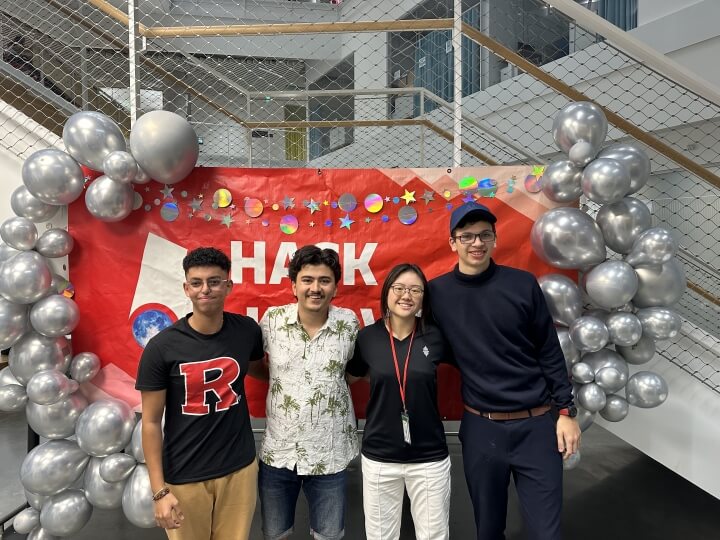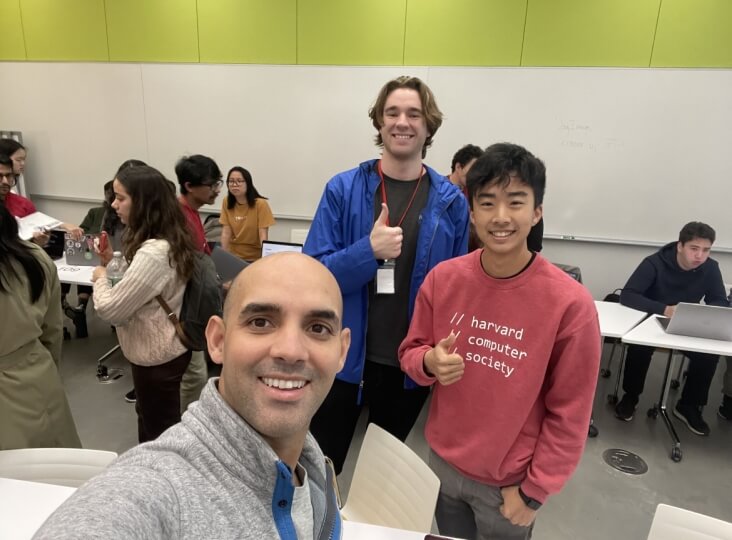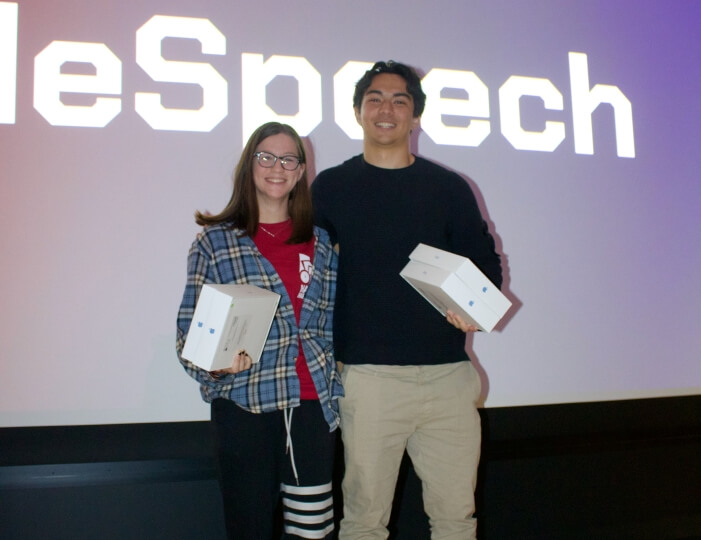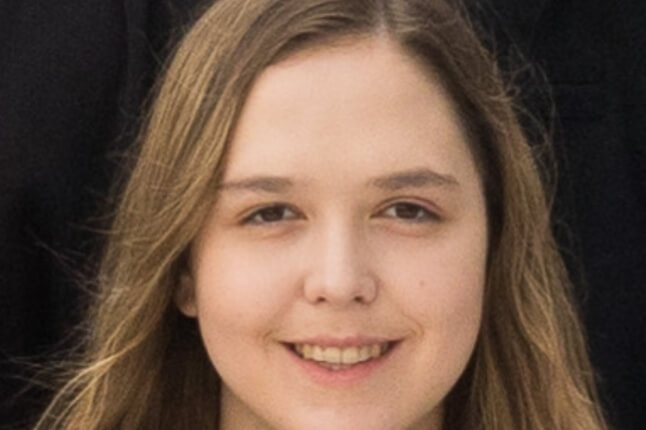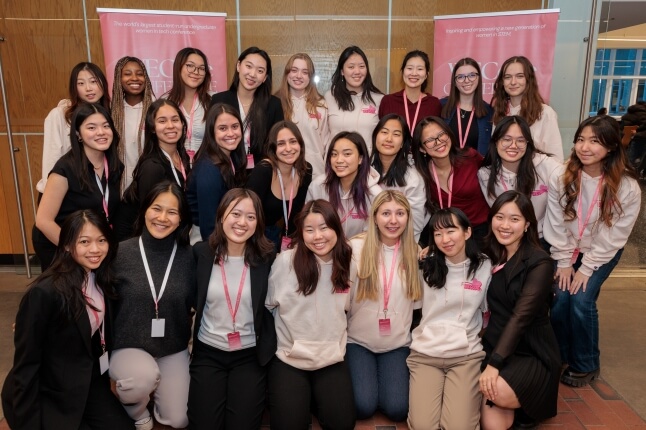News
Students gather in the Science and Engineering Complex for HackHarvard 2023. (HackHarvard)
Emmanuel Rassou wants to make it easier to learn foreign languages. Joshua Zhang finds it easier to get up in the morning with real-time encouragement from peers. Matt Tengtakrool believes satellites can play a crucial role in disaster response. Sahar Maisha doesn’t like to see restaurant food go to waste.
All four are students at the Harvard John A. Paulson School of Engineering and Applied Sciences (SEAS) who recently spent a weekend designing products at HackHarvard 2023 at the Science and Engineering Complex (SEC). They were among the more than 600 students from around the world who participated in the eighth edition of the hackathon – and the first at the SEC.
Teams had 36 hours to design, test and pitch finished products inspired by the overall theme, “Hack to the Future.” Teams submitted products in one of four tracks: Health and Fitness, Earth and Space, ‘So You Think You Can Do It Better, and Efficiency Boosters. The event also featured career and technology panels and social events such as yoga and tote bag painting.
“Overall, I’m super happy with the event,” said director Yuen Ler Chow, a third-year computer science concentrator at SEAS. “Our talks went well and were very well-attended; many were at near- to full-capacity. We sent feedback forms to our hackers, and the overwhelming majority of them were super satisfied with the event.”
Hack Harvard is a SEAS-affiliated student organizations managed by the SEAS Office of Student Experiences and the Office of Academic Programs. Read on to learn more about HackHarvard’s projects and prize winners.
Substitutor team John Tawfik, Aayush Gautam, Beverly Wan and Emmanuel Rassou
SUBSTITUTOR
Rassou, a freshman studying computer science at SEAS, was part of the team that built Substitutor, a Chrome extension that encourages passive vocabulary learning. The extension converts specific chunks of text on a web page into a foreign language, and the user can read the original text by hovering the cursor over it.
Rassou’s team also included Beverly Wan from the National University of Singapore, Aayush Gautam from University of Southern Mississippi and John Tawfik from Rutgers University. The team submitted in the Efficiency Boosters Track.
“Initially we didn’t have a project idea, so the concept creation phase and brainstorming was stressful,” Rassou said. “We thought we were very behind compared to other teams who thought of an idea beforehand. During the last hours, we were coding on pure adrenaline, so we were too tired to even notice any stress.”
SUSTAINABITE
Sustainabite, another Earth and Space submission, connects restaurants with non-profit organizations such as food banks and homeless shelters. Participating restaurants post specific food left over when their kitchens close each day, and organizations within a 10-mile radius get notified of this update and can request the food. Once a request is accepted and confirmed, a volunteer from the organization picks it up within the hour. Maisha’s team included New York University student Catherine Huang, Rocio Cotta Antunez from the University of Minnesota-Minneapolis, and Sarah Asad from the University of Washington.
“This was my first overnight, in-person hackathon and it was unlike any hackathon I've ever participated in before,” said Maisha, a sophomore studying computer science at SEAS. “Working with new people was a lot of fun, and I left the hackathon with two things: new friendships, and a project that brought our team together.”
DRIFTS.space team Montgomery Bohde, Matt Tengtakrool and Ankit Devalla
DRIFTS.SPACE
Tengtakrool, a third-year computer science and statistics student at SEAS, built DRIFTS.space with University of Texas-Austin student Ankit Devalla and Texas A&M student Montgomery Bohde. DRIFTS stands for “Disaster Relief Infrastructure For Tracking and Safety.” The Earth and Space submission analyzes the positions and capabilities of more than 10,000 satellites currently in orbit to determine the ideal positioning to provide real-time data and support for first responders in a region struck by a natural disaster.
“Hackathons are truly special compared to typical school projects because they force you to ship actionable products really fast,” Tengtakrool said. “I think that they force you to be very resourceful, coordinated, and think on your feet.”
WAKEY
Wakey, winner of the Funniest Hack Prize, was submitted in So You Think You Can Do It Better. The app links users who have all set an alarm for the same time, and as one user gets up, they’re able to send additional sound effects or prompts to help everyone else get up. Zhang, a second-year student studying applied math and computer science, built the app with fellow SEAS students Eric Wang and Pedro Garcia, and Princeton student Emily Luo.
“I wanted to gain some computer science background and get more immersed in the culture here,” Zhang said. “We already had a concept in mind, so we basically just got right into the implementation.”
Colorado College students Kylie Bogar and Ronan Takizawa accept the award for Best Overall Hack at HackHarvard 2023. (HackHarvard)
THE WINNERS
Colorado College students Ronan Takizawa, Primera Hour, David Prelinger and Kylie Bogar won Best Overall Hack with TeleSpeech, a Chrome extension that converts Telegram messages into custom AI-generated speech. Second place went to HackAnalyzer, which uses artificial intelligence insights to help hackathon judges evaluate submissions.
The Think You Can Do It Better Prize went to giraffe.study, which uses artificial intelligence to quickly create high-quality videos explaining specific topics. Its design team was from Princeton University, Columbia University and Carleton College.
The Health & Fitness Prize went to GREENTRail, whose design team included students from Parsons School of Design in New York, Indiana University-Bloomington and Northeastern University. The mobile app helps hikers find trails based on a synthesized difficulty rating, while also using wildlife data to suggest routes less likely to affect local fauna.
WaterView won the Earth and Space Prize. Designed by Harvard student Gaurang Goel and several students from the University of Texas, WaterView provides real-time water quality tracking and predictive analysis.
A pair of University of Connecticut students teamed up to win the Efficiency Boosters category with SnipStudy. The program creates summaries of longform videos such as lectures, and with further development could even enable students to search for specific video segments based on keywords or phrases.
Topics: Computer Science, Student Organizations
Cutting-edge science delivered direct to your inbox.
Join the Harvard SEAS mailing list.
Press Contact
Matt Goisman | mgoisman@g.harvard.edu

